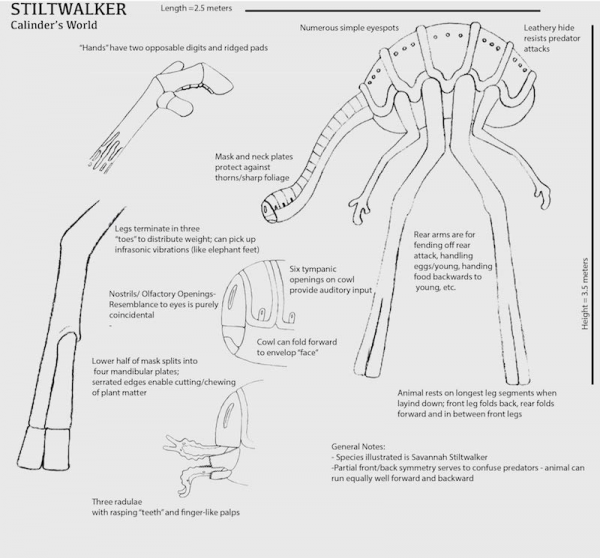BY LETTER
Stiltwalker
Star: YTS -660100-44911-2
Type: KV5
Distance from Sol: 2019 ly
Constellation: Lyra
Location: Cygexpa middle region, near the Zoeific Biopolity border. Eden Institute Scientific Reserve.
Large tetrapodal terrestrial herbivore indigenous to the savannas of the northern continent of Calinder's World, a garden world with an indigenous xenobiota.
Stiltwalkers have a squat sausage-like body with leathery hide, and move by means of two pairs of long but stout jointed chitinous stilts. There are also two pairs of smaller legs that rarely play a part in locomotion. Whilst there are a two rows of eye spots along the back, but smell and hearing are the primary senses (including a sort of long-range sonar). Feeding is via a jointed "mask" at the end of a long muscular proboscis, this bears arrays of radula and is scraped across vegetation. The mashed plant material is then taken up and stored in one of the several stomachs, where it is broken down over several days by symbiotic micro-organisms.
 Image from Steve Bowers | |
| Callinder's World | |
Stiltwalkers have an ungainly stride, not unlike a terragen giraffe, and have been clocked at over 65 km/h in full gallop. In intelligence and in their herding behaviour they are broadly comparable to a terragen ungulate. There are some half a dozen species, the largest, the Great Stiltwalker, attaining a height of 5 meters, a body length of 3.5 meters and a weight of almost a tonne. More common is the Savannah Stiltwalker, which is a little smaller, height when legs are extended about 3.5 meters, body length 2.5 meters, adult weight about 250-350 kg.
The wetter, more forested southern continent bears a distant relative, the stiltworm. This is somewhat smaller, has four pairs of much shorter legs, and a lower more elongate body. It is thought that the two groups diverged from a common 8-legged ancestor during the Paludian Period (in the local geological time span).
The northern Stiltwalkers becoming taller shorter and losing the front and rear pairs of legs (there is an interesting series of fossil forms here, including squat six-legged stiltwalkers and taller forms with two pairs of vestigial stiltlegs adapted to grasping vegetation). While the southern forms became more elongate as the local climate became wetter and the prairies gave way to rainforests.
Appears in Topics
Development Notes
Text by M. Alan Kazlev
Initially published on 31 December 2001.
Initially published on 31 December 2001.







